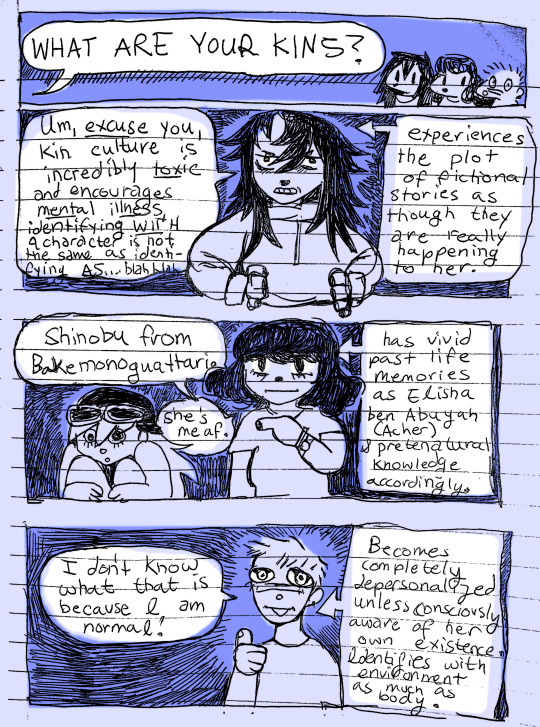#5 subtypes
Text
Enneagram Type 5
An overview of an enneagram type. Not an expert. May change later.
___
Center: Head/Thinking/Fear
Other triads: Competent, Withdrawn, Rejection
Basic motivation: To be competent, knowledgeable
Basic fear: Being useless and helpless
Wings: 5w4, 5w6
Disintegration/stress: 7
Integration/growth: 8
___
Traits
- Strengths -
Insightful
Curious and observant
Analytical and rational
Independent
Innovative and inventive
- Weaknesses -
Detached and distant
Can isolate self too often
Intense, doesn't understand feelings
Nihilistic
Feeling incapable, incompetent
___
Wings
- 5w4 -
5 and 4 are withdrawn types so a 5w4 is a very internalized type. 5w4s often need a lot of alone time to reflect and recharge. This type is a deep and sensitive thinker, very observant and detail oriented. Can be very focused and attentive. They work hard when it comes to things they are passionate about.
- 5w6 -
The 6 wing makes 5 a little more open and receptive to people. They're quite organized and structured with a plan for pretty much everything, considering 5's need to be knowledgeable and 6's need to be prepared all the time. They can be creative problem solvers and are quite practical.
___
Disintegration: 7
Disintegrating to 7 shows up in a 5 as scatterbrained behavior. Easily distracted and impulsive. Can have a hard time concentrating as their mind is filled with too much and keeps jumping from one thing to the next. A disintegrated 5 is very restless.
Integration: 8
Integration to 8 means a 5 is learning to become more comfortable in participating in the real world. Fear no longer makes them want to hide away all the time. They are capable of living outside of their minds and fully living in reality. They don't get stuck analyzing choices over and over again to the point of paralysis - they learn to just do things regardless of their paranoia.
___
Subtypes of 5
- Sp 5 -
Sp 5s are the most protective over their time and energy. They have clear boundaries they are not shy to set. Sp 5s have a need for independence and will not allow anyone or anything to take it away from them. This subtype is much more of an observer of life rather than a participant. They would rather focus their time and energy into personal projects that bring them life.
- Sx 5 -
Sx 5s are less concerned with boundaries as they seek to find a person who has a similar mindset like them. They want to find someone who can truly understand them so that the sx 5 can comfortably open up their private world to them. However, their independence can still make them fearful - it can take a lot of time for them to genuinely open up. They try to attract by having various interests and having interesting inner lives.
- So 5 -
So 5s want to be seen as competent and wise by others. They want to be seen as intellectual and so will be drawn to opportunities that allow them to showcase their knowledge and skills. However, their need to be alone conflicts with the desire to be viewed as an intelligent role model. They don't want to be overwhelmed by the world yet still want to participate in it. Although a social subtype, they may still struggle to connect with others, but they will still be drawn to like minded individuals.
___
Enneagram list
___
Side blogs:
Kpop astrology @rainy-astrology
Kpop fanarts @rainy-artworks
#enneagram#enneagram 5#5w4#5w6#typology#typology notes#ennea type 5#type 5#subtypes#5 subtypes#sp 5#so 5#sx 5#disintegration#integration
67 notes
·
View notes
Text
Subtype Trait Structures: sp5
Retentiveness
The conservation E5 keeps their emotions and thoughts to themselves. This subtype has learned to be self-sufficient, since he does not expect much from the world. They stick to themselves, being pessimistic about receiving care and protection, or being able to take what they need.
Not Giving
This subtype has the fantasy that, by giving, it will lose what little it has. The conservation E5 fears commitment, since it implies a debt that he does not feel capable of satisfying. He wants to be completely free, without obstacles, without ties to anyone. They do not feel like they have much to give.
Detachment
The conservation E5 withdraws from the world; detachment is a form of withdrawal. They do not feel the need to relate, nor are they interested. Deep down, they fear not being capable of filling the other's expectations.
Fear of Being Swallowed
The conservation E5 has the most difficulty with setting limits of the E5 subtypes. He feels used and abused, confirming his disappointment with the world. Anger is not expressed, rather, this subtype chooses to disappear. They protect their private space as much as possible, being susceptible to invasion.
Excessively Docile
Over-docility leads this subtype to interfere with his own spontaneity and with his preferences. This over-docility would not be possible without a strongly repressed need for love.
Self-sufficient
The conservation E5 is independent, due to the fear of being swallowed, and due to the belief that he does not have much to give. He does not ask for help; the world is not to be trusted. This mistrust originated from the primary relationship with the caregivers, who did not respond adequately to the person. Experiencing great frustration when not being able to support others, the conservation E5 chooses to retire from relationships. Despite his self-sufficiency, his material life is often lacking, because he does not need much either. This subtype can choose low-paying jobs because he values independence above all else.
Emotionally Insensitive
Despite being sensitive, the conservation E5 buries his emotions, and nobody knows about them. He has “learned” that what happens to him is not relevant, and that showing emotions will cause discomfort. He can forget how he feels, leading to anhedonia. It is difficult to express emotions.
Orientation to Knowledge
Knowledge becomes a safeguard in the face of the world. It can be a way of relating to the other. Knowledge brings order and analysis to chaos. Everything is safer in the mind, where he is completely free and autonomous.
Strangeness
Suppressing feelings and avoiding life impoverishes the experiences of the conservation E5. He feels empty on the inside. He describes it as an existential desert. This feeling of living dead is due to the disconnection with the body and the emotions. It is also a feeling of strangeness that makes him feel lost, like a weirdo on the planet. He does not feel belonging to this world.
Guilt
The conservation E5 feels guilt for existing, as if he did not deserve life, as if his existence was a mistake. This subtype will blame himself for everything. By embracing a detached indifference, they feel guilty. Guilt can manifest as a vague sense of inferiority, a vulnerability to intimidation, and shyness.
Self-demanding
This subtype is a perfectionist who feels like a “loser.” He is very demanding of himself, and over-analyzing his actions leads to a sense of lack.
Negativism
The conservation E5 is an oppositionist and a rebel on the inside. His anger manifests as passive-aggression. They can be forgetful and evasive. He does not like being told what to do.
Hypersensitivity
Hypersensitivity is an introverted disposition. This subtype feels unprotected against environmental stimuli. Emotional numbness is a way to protect against overstimulation. He does not want to interfere with the world; he does not want to harm or interfere. The most obvious manifestation of sensitivity and compassion will be towards nature and animals.
Renunciation of Action
The conservation E5 tends to procrastinate. Inaction can manifest as non-commitment, passivity, and apathy. Inaction can be the result of wanting to keep his intentions hidden.
Source: PDB Wiki
#personality theory#personality types#typology#enneagram#enneagram subtypes#instinctual variants#enneagram 5#type 5#5w4#5w6#sp5#intj#intp#istj
97 notes
·
View notes
Text
(can't stop having violent, sexual intrusive thoughts) i don't think i have ocd because my room is messy
#can't believe it took me until college to not only realize i had it but also how severe my case was#i had no idea there were subtypes so when i found a full list of them i counted how many i related to and once i got past 5 i gave up#tw mental health#tw ocd#journal#rant
11 notes
·
View notes
Text
Most common enneagram mistypes (also by instinctual subtype) and short explanation for mistype
Type 1
In general: E3 (focus on competence), E4 (when unhealthy), E5 (focus on competence)
Sx1 (countertype): E8 (both have a forceful nature)
Type 2
In general: E9 (positive attitude)
Sp2 (countertype): E7 (positive attitude; childish disposition)
Type 3
In general: E1 (focus on competence), E5 (focus on competence)
So3 and Sx3: E8 (assertive attitude)
Type 4
In general: E2 (especially when unhealthy), E3 (especially with 3 wing), Enneagram 5 (withdrawn stance; especially with 5 wing), E9 (withdrawn stance)
Sx4: E8 (reactive triad; might mistype due to forceful nature)
Type 5
In general: E1 (focus on competence), E4 (withdrawn stance; especially with wing 5 or if sx subtype), E9 (withdrawn stance)
Type 6
Sp 6: E2 (dependent stance), E5 (especially with a 5 wing), E9 (attachment triad)
So 6: E1 (dependent stance), E3 (attachment triad; especially when unhealthy)
Sx 6 (countertype): E3 (attachment triad; especially when unhealthy), E4 (reactive triad), E7 (especially with 7 wing), E8 (reactive triad)
Type 7
In general: E3 (assertive attitude), E4 (frustration triad), E8 (assertive attitude)
So 7 (countertype): E2 (positive attitude; they both have a self-sacrificing nature which may be the cause of mistype)
Type 8
In general: E3 (assertive attitude), E7 (assertive attitude
Type 9
In general: E2 (positive attitude; especially if social subtype), E4 (withdrawn stance), E5 (withdrawn stance), E7 (positive attitude)
Main sources: Naranjo, Hudson and Riso, Beatrice Chestnut
Remember to always check basic needs/passions/desires when in doubt between two enneatypes! Enneagram is not as much as outward behavior as it is about your internal feelings. Checking integration/disintegration patters can also be useful.
Hope this helps someone! :)
#enneagram#enneatypes#mistype#typology#psychology#enneagram 1#enneagram 2#enneagram 3#enneagram 4#enneagram 5#enneagram 6#enneagram 7#enneagram 8#enneagram 9#tritype#instinctual variants#instinctual subtypes#naranjo#hudson and riso#beatrice chestnut
128 notes
·
View notes
Text

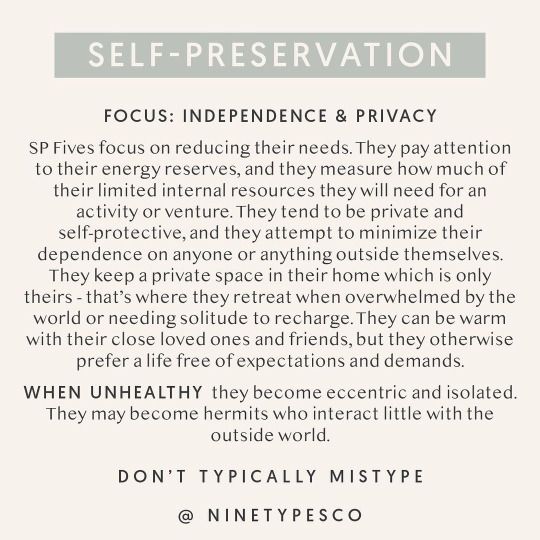
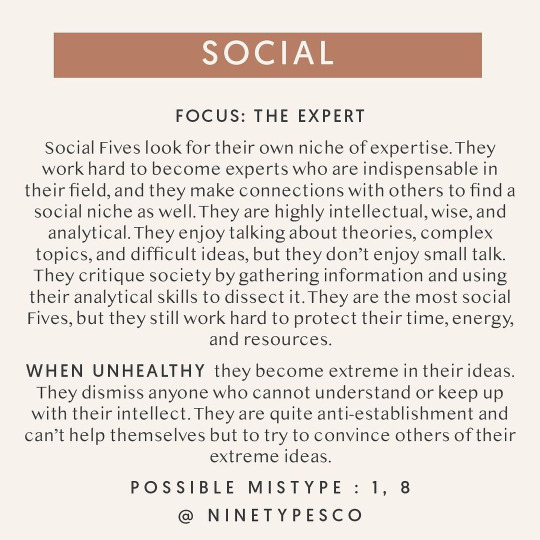
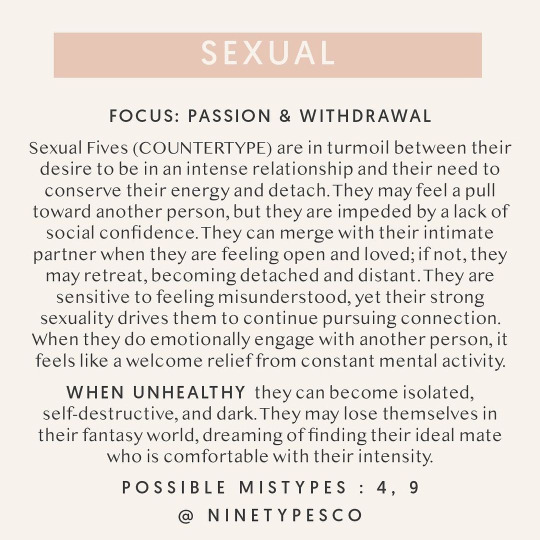
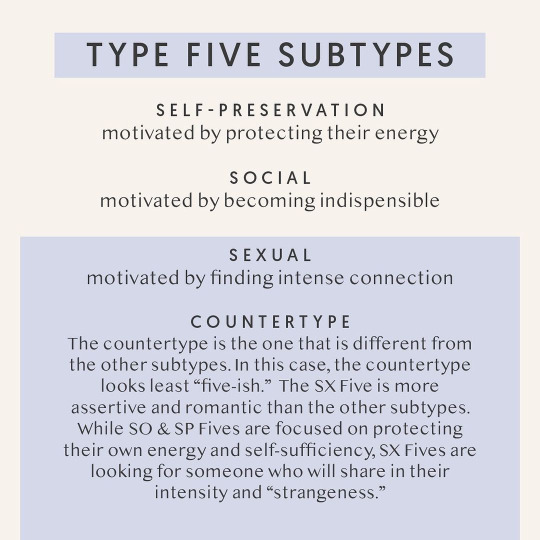
Subtypes: Type Five. From NineTypesCo by Steph Barron Hall.
4 notes
·
View notes
Text
WHY WOULD THE ENNEAGRAM BETRAY ME LIKE THIS
#I... think I might be a 4w5???#instead of the other way around???#reading about type 5s is like ‘oh yeah technically I'm like that’#but reading about 4s is like they transcribed my inner monologues#how does my subtype apply tho??#bc sx 5 and sx 4 both make sense#but the sx 4 description makes it sound really dramatic when I think it's much more subtle#for me at least#and I wouldn't describe myself as hateful or competitive#so what's up with that#enneagram tag#nathan rambles
7 notes
·
View notes
Text
i say sorry that's so 5e focused but honestly that post exemplifies my main issue with d&d. it's so horizontal and there's so many ways magic manifests, but it feels... incoherent. in my settings one of the first questions i run into is "what is magic, how does it come about, why does it work, what is its relationship with divinity, etc" and like, those aren't questions you get in 5e beyond a vague "it suffuses the universe, it's a fundamental force, the gods have control over it, something something"
like it doesnt feel like there's a real answer to any of these questions it's just handwaved and left to the DM's discretion. and idk... to me that is a shame because the best magic systems are specific and limited and they have a special relationship with the people who use it. and in rpgs it is really fun when the mechanical systems that you interact with feel equivalent to the in-universe systems they're replicating. so my settings always end up mimicking the in-game system (spell levels are a real thing, power is measureable and discrete, only sorcs are really able to go in between spell levels) which makes it feel samey and dull imo. i really want to run a different system tbh
#ALSO#im not putting this in the main body of the post because it is an entirly personal gripe but#i dont like that paladins bards sorcs monks etc arent a subtype of any other class#like IMO there should be a few main 'types' of character#max like 4 or 5#and then there should be types of each one#druids and clerics being equal doesnt tell you anything about their relationship to magic and how they compare to each other !!!!#same with paladins#u cld have them be a subset of 'fighters' or a subset of 'worshippers' and both of those would be more interesting to me#because it tells you about where a paladins main strengths lie it tells you what their relationship to divinity is and it tells you what#they started out learning and what they picked up later#idk !!! it has potential i feel like#its worse for system functionality in d&d but whatever i dont care#i like how force and destiny did jedi
2 notes
·
View notes
Text
so my crush of five years SHUT UP I KNOW IM A REAL LIFE HIMBO IT’S COMPLICATED did Not. understand the wholeass love poem i wrote specifically for him. so now i’m gonna try to meet his plant [fixation???] (he’s not ND to my knowledge. then again-) by learning to draw and doodle flowers with specific meanings
……… i still don’t think it’s working
#you know the ‘idiots in love’ tag? yeah p sure that’s us at this point#like. i Mentioned the plant symbolism page to him at one point#and he agreed it was like. where we met in the middle (him w plants and me as an author)#and i even Asked him. about the difference between daffodils/jonquils/narcissus the other night#more in a botany/linguistic sense but like#daffodils are ‘uncertainty. chivalry. respect or unrequited love. return my affection; new beginnings’#jonquils are ‘return my affection’#and ignoring the ‘selfishness’ lol. narcissus is ‘unrequited love’#if ur wondering. daffodils and narcissus are basically the same. narcissus is the latin name for the genus#whereas jonquils are a subtype#god now because im ranting in the tags. i said ‘oh so like the whole not all rectangles are squares thing’#this is at like. 1:30 in the morning fyi#he comes back like 5-10mins later and gave me a list of like. the taxonomic classifications of a square#and. i shit u not. for 40 minutes. we then discussed the logistics of this#i May or may not be falling just a lil#oh yeah but with all those mentions of daffodils#pretty sure it’s still flying over his head on god#wait i’ll reblog with the examples cause GOD HAHSJDJANSN#personal
4 notes
·
View notes
Photo

-
Fancy coincidence, I just made some cards that synergize great with this!

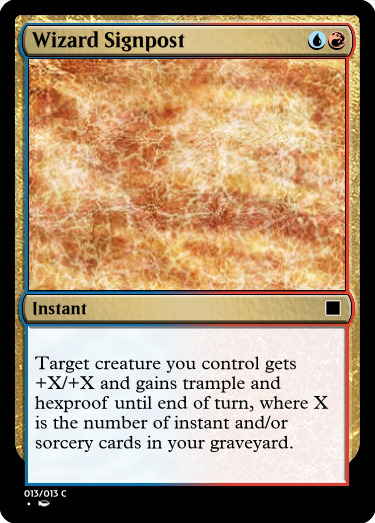
They’re part of a signpost set based around the amass mechanic. When it comes to getting +1/+1 counters on creatures, it’s hard to get more efficient than amass!
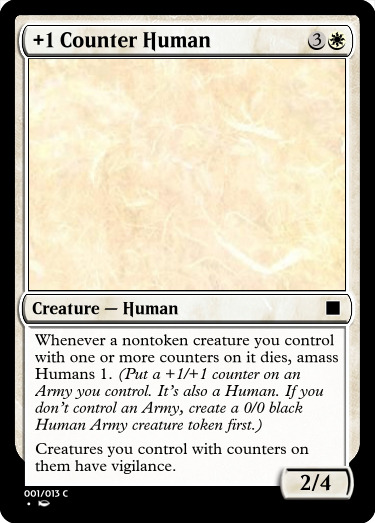
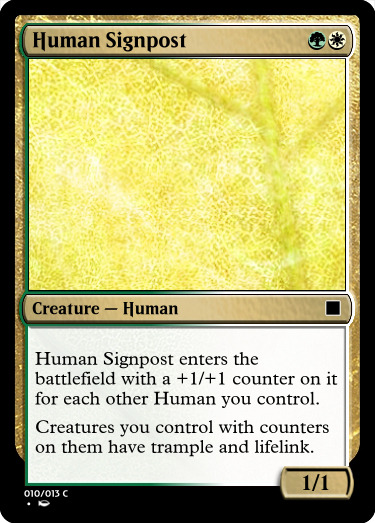

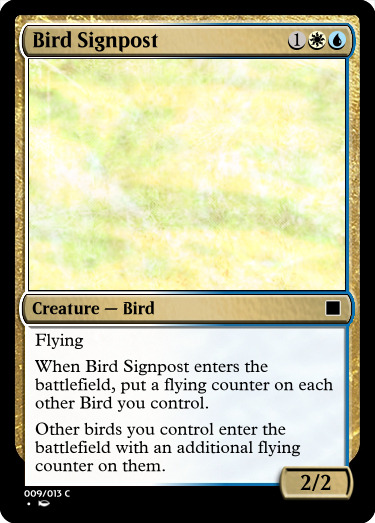

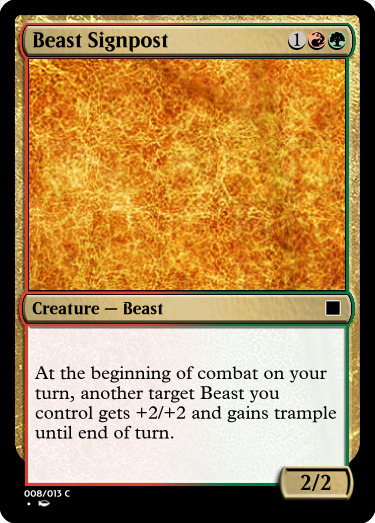
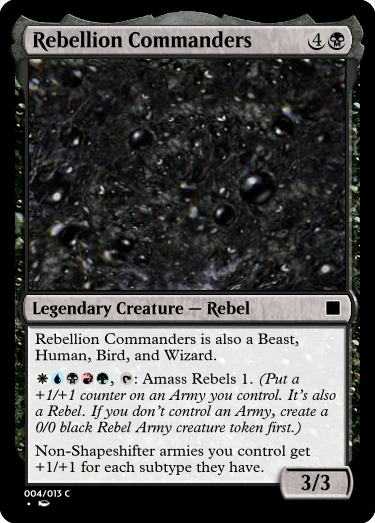
And this whole thing was inspired by me wanting to make skeleton army cards to celebrate the annual SKELETON WAR!
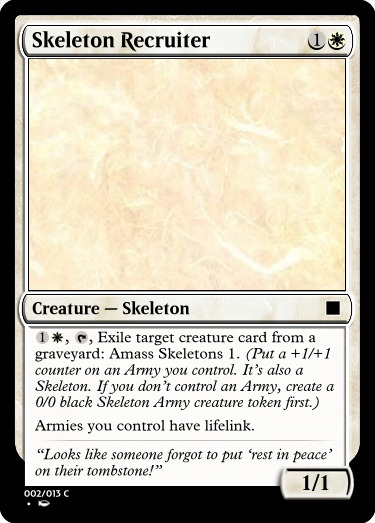
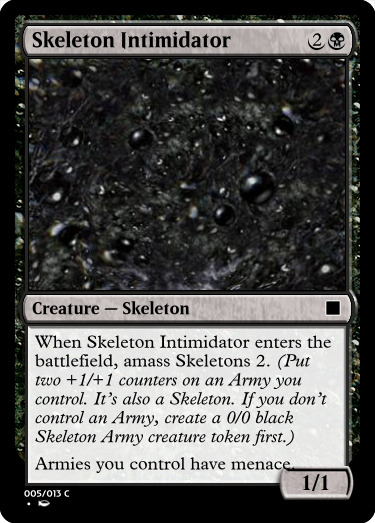
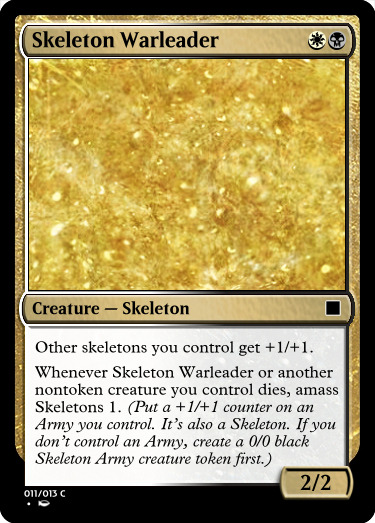
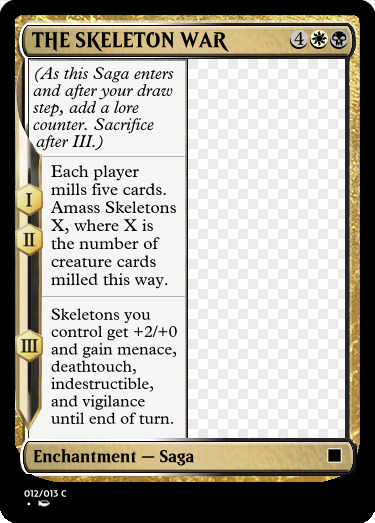
#asks#god FUCKING damn it the text on Skeleton Warleader doesn't capitalize skeleton#also it should really say 'Skeleton creatures' not just skeletons#that's important for dependencies that make continuous effects apply in the correct order#actually i don't know how that would work#what would happen if you gave a noncreature permanent +1/+1 and then turned it into a creature?#i think it would still have the effect on it right?#anyway#i really like the new change to the amass mechanic#when i saw that amass always made zombies i was like#'wait so they'll never use amass again unless there's another zombie army?'#'what about a soldier army or something?'#so now they fixed it!#still always black though which limits the flavor#also the way they changed it means you can stack multiple subtypes on your army#which inspired Rebellion Commanders#also i planned to make a proper 5 archetypes but i came up with 4 good ones and black just didn't fit anywhere#so this is a 4-color set i guess lol#also returning mechanic: feather dance!#also thought about making THE SKELETON WAR a battle but i didn't know what the back side would be#and making it a saga works too#custom cards
0 notes
Text
Enneagram system
A rewrite/more in depth post of the Enneagram system compared to my last post on it. Not an expert. May change later.
If you like kpop and typology, check out my blog. I do type analysis on idols and typology notes.
___
What is Enneagram?
I mainly took notes from Riso Hudson theory.
A typology system that categorizes personalities into 9 different types. Each type is numbered from 1 - 9.
Each type has a desire and fear that motivates their actions in life.
Core and Wings
Core: Our main type. It is the foundation of our personality and does not change.
Wing: Acts as a complement to our core. Wing can be one of the two types that sit beside core type. E.g a core 2 can have a 1 wing (2w1) or 3 wing (2w3). But is not necessary to use since wings can change and/or can be balanced.
Levels of Development
Summary of healthy - unhealthy levels of personality
- Healthy levels -
Level 1: Liberation
Let go of self image so we are free to express ourselves however we want. Self acceptance of all traits.
Level 2: Pyschological Capacity
Begin to identify with positive qualities in our personalities and learn to improve ourselves with them.
Level 3: Social Value
Still strongly identify with our set self image and make effort to maintain image. Want to share our good talents and abilities to make a positive effect on self and others.
- Average levels -
Level 4: Imbalance/Social roles
Idealization of self image; have a major focus on either good or bad qualities, no in between. Fear is an obstacle here.
Level 5: Interpersonal Control
Insist on self image being accepted by others, which can cause conflict. Can lead to controlling and manipulation.
Level 6: Overcompensation
Overcompensate due to underlying negative feelings. Desperate for others' acceptance.
- Unhealthy levels -
Level 7: Violation
Desperation for acceptance leads to violation of one's self and others. Serious conflict can occur. May victimize themselves to excuse offensive actions.
Level 8: Obsession and Compulsion
May be overly obsessed with an image of who they want to be. Deceives others
Level 9: Pathological Destructiveness
Most unhealthy state, display very toxic traits and behaviours, may have mental breakdown
Disintegration vs Integration
Or basically Stress vs Growth
Disintegration: When under heavy amounts of stress, a type will go into their disintegration type. They will pick up the negative traits of that type and act like the unhealthy version of it.
Integration: When maturing/developing positively, a type will go their integration type. They will pick up the positive traits of that type and improve their character.
___
* I will only give short descriptions for the triads. I will explain more in depth in individual posts.*
Centers of Intelligence
There are 3 centers of intelligence. Each center shows how and why we solve issues in life.
Gut/Instinct/Anger (types 1, 8, 9)
Gut center focuses on reacting and taking action immediately. This triad has an issue with control and anger.
1: Often perfectionists who repress their anger in order to remain morally good. They see their anger in a negative light.
8: The most open and comfortable with their anger. Uses it to assert boundaries, especially since this type fears vulnerability.
9: Often a passive type that dismisses or downplays their anger. They fear conflict and may worry being more assertive will cause a negative effect on themselves and others.
Heart/Image/Shame (types 2, 3, 4)
Heart center focuses on self identity and connections. This triad wants love and recognition and do what they believe is best to get that. They struggle with self worth.
2: They want to be needed and helpful to others. Pride themselves on being of service. Wants to receive love and to give love.
3: The most image oriented type. They always try to show their best selves and best efforts in order to seem admirable. Fears being worthless.
4: Wants to create a unique image for themselves, believes being boring will make them unloveable.
Head/Thinking/Fear (types 5, 6, 7)
Head center focuses on ideas, making rational decisions, and gathering info. This triad deals with fear and uncertainty.
5: The most internalized head type. 5's want to gather as much knowledge and resources as possible in order to stay secure and independent.
6: Quite an anxious type who seeks security through relations with others.
7: This type fears pain and suffering and seek out experiences in order to avoid negativity.
___
Other triads
- Harmonic Triads -
How types handle conflict, coping mechanism
Reactive (4, 6, 8)
Reactive types are not afraid to show and speak about their true feelings. They may seem "dramatic" in a way.
4: Melodramatic and self absorbed in negative feelings, drowns in intensity
6: Will argue, stick up for the right thing, moody, anxious
8: Big and loud reactions, can be very fiery
Positive (2, 7, 9)
Positive types dislike negativity and conflict and have their own ways of avoiding such tension. Optimistic during hard times.
2: Actively tries to be a good and kind person, only tries to focus on the good aspects of people
7: Seeks out fun opportunities to make their life exciting (basically distraction)
9: Values harmony and peace, will not risk any type of action that will disturb these values
Competency (1, 3, 5)
Competent types are often perfectionists who want to show their best selves. Objective and rational.
1: Strives to be correct and right, wants to be precise in what they do
3: Represses softer emotions to keep up a certain image, thrives with work/passions so they can be the best at what they do
5: Detached from feelings to remain logical and objective, knowledge seeking
- Hornevian Triads -
Relationships with others, how they get what they want
Assertive (3, 7, 8)
Assertive types go against people to get what they want. Do not back down easily, can seem aggressive and forceful.
3: Pushes through obstacles for achievements, goal oriented
7: Asserts their right to have fun, refuse to be restricted
8: Asserts power and strength, places boundaries
Withdrawn (4, 5, 9)
Withdrawn types are very internalized and do not show their needs openly. Deals with things alone.
4: Feels something is wrong with them internally, feels misunderstood
5: Detached from others as to not drain their own energy, will figure it out themselves
9: Introspective, lets life happen
Compliant (1, 2, 6)
Compliant work with people to get what they want. Builds relationships for security, wants to be helpful to others.
1: Doing the right thing instead of one's own wants
2: Focus on other's needs more instead of self
6: Tries to build a safe and secure environment by getting ppl to work together
- Object Relations -
How we are affected by others, our own affect on others, how we react to personal wounds
Attachment (3, 6, 9)
Seek out bonds and companionships for particular reasons. Individuality vs adaptation.
3: Changes their image to suit whoever they are with in order to meet expectations
6: Creates support systems to help with their self doubt and indecisiveness
9: Adapts to the energy of the environment to keep harmony
Frustration (1, 4, 7)
Triad gets frustrated when their needs aren't met.
1: Has a need to improve every little imperfection they find
4: Dislikes shallowness, longs for depth and complexity
7: Not enjoying experiences, not feeling fulfilled
Rejection (2, 5, 8)
Their own needs feel unimportant to others, so they reject their own needs as well.
2: Rejects the need to receive love and guidance, instead focuses on connecting with others and helping them.
5: Ignores and minimizes all their needs, offers knowledge and expertise in some hope of being acknowledged for their intelligence.
8: Rejects by being never putting their guard down, wanting to appear strong and as the protector of others.
___
Subtypes
Claudio Naranjo theory
There are three subtypes/instinctual variants that show our drive in life. There are 27 different subtypes in total.
Self Preservation (Sp)
Focuses on physical safety and security. Our physical health, financial security, obligations, and comforts.
Sexual/One - on - one (Sx)
Wants intensity and deep connections, one on one relationships are preferred.
Social (So)
Prefers to be in a community, wants to create good connections and bonds with others. Socially aware, focus on group goals and contributions.
___
Tritype
Katherine Fauvre theory
A minor but still interesting piece of Enneagram. Tritype is formed of your 3 dominant types from each center. The first number will always be your core, followed by your other 2 dominant types.
E.g 369. 3 = core, heart. 6 = head. 9 = gut.
___
Enneagram notes
___
Side blog:
Kpop astrology @rainy-astrology
Kpop fanarts @rainy-artworks
#enneagram#enneagram types#typology#mbti#enneagram notes#tritypes#triads#enneagram triads#instinctual variants#subtypes#enneagram personality#personality theory#enneagram 1#enneagram 2#enneagram 3#enneagram 4#enneagram 5#enneagram 6#enneagram 7#enneagram 8#enneagram 9#integration#disintegration#stress#growth
101 notes
·
View notes
Text
The Best News of Last Week - March 18
1. FDA to Finally Outlaw Soda Ingredient Prohibited Around The World

An ingredient once commonly used in citrus-flavored sodas to keep the tangy taste mixed thoroughly through the beverage could finally be banned for good across the US. BVO, or brominated vegetable oil, is already banned in many countries, including India, Japan, and nations of the European Union, and was outlawed in the state of California in October 2022.
2. AI makes breakthrough discovery in battle to cure prostate cancer

Scientists have used AI to reveal a new form of aggressive prostate cancer which could revolutionise how the disease is diagnosed and treated.
A Cancer Research UK-funded study found prostate cancer, which affects one in eight men in their lifetime, includes two subtypes. It is hoped the findings could save thousands of lives in future and revolutionise how the cancer is diagnosed and treated.
3. “Inverse vaccine” shows potential to treat multiple sclerosis and other autoimmune diseases
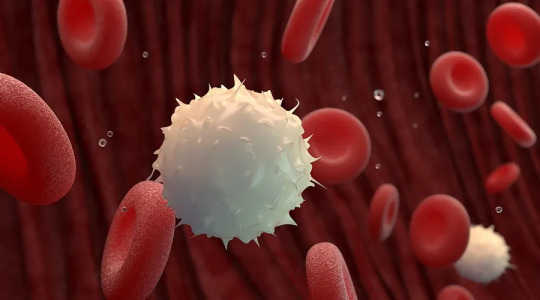
A new type of vaccine developed by researchers at the University of Chicago’s Pritzker School of Molecular Engineering (PME) has shown in the lab setting that it can completely reverse autoimmune diseases like multiple sclerosis and type 1 diabetes — all without shutting down the rest of the immune system.
4. Paris 2024 Olympics makes history with unprecedented full gender parity

In a historic move, the International Olympic Committee (IOC) has distributed equal quotas for female and male athletes for the upcoming Olympic Games in Paris 2024. It is the first time The Olympics will have full gender parity and is a significant milestone in the pursuit of equal representation and opportunities for women in sports.
Biased media coverage lead girls and boys to abandon sports.
5. Restored coral reefs can grow as fast as healthy reefs in just 4 years, new research shows

Planting new coral in degraded reefs can lead to rapid recovery – with restored reefs growing as fast as healthy reefs after just four years. Researchers studied these reefs to assess whether coral restoration can bring back the important ecosystem functions of a healthy reef.
“The speed of recovery we saw is incredible,” said lead author Dr Ines Lange, from the University of Exeter.
6. EU regulators pass the planet's first sweeping AI regulations

The EU is banning practices that it believes will threaten citizens' rights. "Biometric categorization systems based on sensitive characteristics" will be outlawed, as will the "untargeted scraping" of images of faces from CCTV footage and the web to create facial recognition databases.
Other applications that will be banned include social scoring; emotion recognition in schools and workplaces; and "AI that manipulates human behavior or exploits people’s vulnerabilities."
7. Global child deaths reach historic low in 2022 – UN report

The number of children who died before their fifth birthday has reached a historic low, dropping to 4.9 million in 2022.
The report reveals that more children are surviving today than ever before, with the global under-5 mortality rate declining by 51 per cent since 2000.
---
That's it for this week :)
This newsletter will always be free. If you liked this post you can support me with a small kofi donation here:
Buy me a coffee ❤️
Also don’t forget to reblog this post with your friends.
737 notes
·
View notes
Text
Subtype Trait Structures: sx5
Fragile Body and Nonconformist Spirit
Usually, this subtype has experienced a childhood of suffering due to the affective impact of the parents, but also due to physical fragility. Despite this, there is an intense desire for potency. The sexual E5 does not accept its fragile condition.
Need of Harmony and Flee to Nature
A person of this subtype needs a harmonious environment. Nature becomes this environment; it is an idealized place of silence and tranquility, where the sexual E5 can organize his inner chaos.
Arid and Hypersensitive
The sexual E5 appears arid and distant, and yet is very sensitive. There is a very low threshold for pain, so emotions and thoughts are separated, and situations are avoided which might bring to conscious awareness extreme pain. Aridity serves to dampen hypersensitivity.
Easily Destabilized
People make this subtype lose contact with his desires. External demands exhaust the sexual E5 and thus cause this subtype to retreat once more into isolation. The sexual E5 was so invaded in his childhood that the person still lives with the fear of not being able to defend him, thus the person remains in the background.
Nostalgic
The sexual E5 idealizes the past, being unable to let themselves indulge in the present.
Helpless
Existential helplessness has been present since childhood. It almost feels like having no skin, not being grounded in the world.
Separation From The World
Separating social and professional dimensions can lead to a simple, routine life. The sexual E5 can restrict himself to a systematic and rigid way of living, and compensate this with excessive fantasy. The sexual E5 is pressured by an indomitable spirit, but has difficulty finding his place in the world.
Worthless
A prominent characteristic of E5 is not feeling worthy, due to a lack of vitality when facing challenges. With the sexual instinct, it coexists with excessive and grandiose fantasy. Projects thus become unreal and unfinished. Separating the mind from the body makes it difficult to take action.
Indiscipline
Indiscipline is the result of forgetfulness, devitalization, and difficulties taking action. It is hard to move on, due to a pessimistic attitude towards change. Internal perfectionism makes the sexual E5 believe he is never ready.
Vengeful by Not Doing What is Expected
The demands of an internalized critical parent makes this subtype rebellious, which results in guilt when not doing what is expected.
Guilty Feelings
Guilt arises, as the sexual E5 is aware of their detachment as a form of revenge. A vicious cycle is created: guilt leads to not having energy, and not having energy leads to guilt. Guilt maintains feelings of victimization. A childhood full of demands and messages of worthlessness is common. The parents, making the sexual E5 feel guilty, contribute to a sense of worthlessness, of not being deserving of something positive in life.
Selfishness and Egocentricity
When idealizing his partner, the sexual E5 does not see her as a person with her own emotions or needs. This subtype needs a partner who will have extreme loyalty. The other must conform to this person.
Arrogant
As a way of denying the defensiveness of isolation, the sexual E5 will convince himself of his special world, of being above “ordinary” beings. There exists an image of superiority. This subtype tends to present his ideas as unquestionable.
Seductive
The sexual E5 seduces not with feathers, but by approaching intimately. His search for the ideal partner can lead to compulsive seduction of different people at the same time.
Romantic
The sexual E5 is the most emotional subtype of the E5. Romanticism allows them to be carried away by their emotions. Romanticism can emerge not only in the couple's relationship, but also with music, art, or nature.
Source: PDB Wiki
#personality theory#personality types#typology#enneagram#enneagram subtypes#instinctual variants#enneagram 5#type 5#5w4#5w6#sx5#infj#intj
39 notes
·
View notes
Text
Maro’s Teaser for Murders at Karlov Manor
Before previews for Murders at Karlov Manor officially begin, I thought it would be fun to do another of my Duelist-style teasers where I give tiny hints of things to come. Note that I’m only giving you partial information.
First up, here are some things you can expect:
• white gets a card that lets you play a subset off the top of the deck
• a new enchantment subtype Case
• a card with four different hybrid symbols in its mana cost
• a popular mechanic returns tweaked with a new name
• a green sorcery that you can have any number of in your deck
• a keyword mechanic not printed in a premier set since 2008 returns on a single card
• a creature that allows you an alternate nonmana cost for all your spells
• some creature tokens in the set: (note that some have abilities) 0/0 green Ooze, 0/0 colorless Thopter (also artifact), 0/1 green Plant, 1/1 black Bat, 1/1 white Dog, 1/1 red Goblin, 1/1 white Human, 1/1 blue Merfolk, 1/1 white and black Spirit, 1/1 colorless Thopter (also artifact), 2/1 black Skeleton, 2/1 black and green Spider, 2/2 white and blue Detective, 2/2 red Imp, and 5/5 green and white Wolf
• And yes, Murder is in the set
Next, here are some rules text that will be showing up on cards:
• “Whenever a creature an opponent controls dies, if its toughness was less than 1, draw a card.”
• “Choose any number of target players.”
• “Creature cards in your graveyard gain ‘You may cast this card from your graveyard’ until end of turn.”
• “Then sacrifice it if it has five or more bloodstain counters on it.”
• “you may search your graveyard, hand, and/or library for a card named Magnifying Glass and/or a card named Thinking Cap and put them onto the battlefield.”
• “target opponent gains control of any number of target permanents you control.”
• “If an ability of a creature you control with power 2 or less triggers, that ability triggers an additional time.”
• “As long as there are no cards in your library,”
• “If one or more tokens would be created under your control, those tokens plus a Clue token are created instead.”
• “Whenever you sacrifice a Clue, target opponent gets two poison counters.”
Here are some creature type lines from the set:
• Creature – Vedalken Artificer Detective
• Creature – Ogre Cleric
• Artifact Creature – Insect Thopter
• Creature – Lammasu
• Creature – Weird Detective
• Creature – Goblin Bard
• Creature – Viashino Assassin
• Artifact Creature – Clue Fish
• Creature – Elf Crocodile Detective
• Legendary Creature – Mole God
Finally, here are some names in the set:
• Airtight Alibi
• Caught Red-Handed
• Deadly Cover-Up
• Eliminate the Impossible
• Homicide Investigator
• Innocent Bystander
• It Doesn’t Add Up
• Person of Interest
• Private Eye
• Scene of the Crime
Follow the story each day this week and tune into the debut at 9:00 am PT on Jan 16 on twitch.tv/magic or youtube.com/@mtg to learn whodunit! Can you solve the mystery before detective extraordinaire Alquist Proft?
408 notes
·
View notes
Note
top 5 funniest mtg combos. not best, just funniest
I'm gonna limit this to ones that use tournament legal cards, and not ones that use the much sillier silver border cards that dip into weird territory that can get you results like "tear your hand in half" or "destroy every magic card" or "force your opponents to do the hokey pokey ad infinium"
5. The combo that puts your entire deck into the command zone (normally, no cards go to the command zone except the one or two things that started in there if you're playing the right format)
4. Okay you know how I said we wouldn't be using silver border cards? Well check this out. This combo makes a silver-border card relevant using entirely tournament legal cards. This combo would be higher, except the rules have now changed so this doesn't work. If you make a token without specifying the name, it's now [subtype] token instead of just [subtype].
3. The combo that makes mtg a turing complete game (special bonus points to this one for being an actual paper)
2. The combo that builds on mtg being turing complete with this nonsense
1. The combo that turns mtg into Uno
323 notes
·
View notes
Text
The beginner autistic guide to common terms in our community (with extra context!).
*Disclaimer, I’m not a professional. This is just knowledge from my experience as an autistic person. Please feel free to correct anything :)
These definitions will include some of my own opinions and thoughts, especially on the more controversial terms. This is simply to help better prepare new autistic community members for conversations they become engaged in. Having all the perspective and context you can have can be very helpful when moving into new social spaces.
Autism (Or Autistic Spectrum Disorder, ASD): A neurodevelopmental disorder that is present from very early childhood. It’s mostly recognised through difficulties with social interaction and restricted and/or repetitive behaviours. The way it is referred to as “Autism Spectrum Disorder” is specifically referring to the fact that autism presents in countless ways. There are common traits and patterns, but the severity and complexity of those traits and symptoms is infinite.
NOTE: This does not mean that ‘everyone is a little bit autistic’. You are either autistic or you are not. It just means that if you have autism, it may present very differently to other autistic people you know.
Asperger’s Syndrome: Asperger’s syndrome is usually considered an older term for a ‘subtype’ of autism. The term is considered outdated by the DSM-5 and no longer used in that document. However it is still used in a lot of other countries. Now it is becoming more socially known that ‘Asperger’s syndrome’ is just a specific presentation of autism. Many autistics don’t like the use of the word ‘Asperger’s’ because of a couple reasons:
The term has a long history with NAZI’s and eugenics.
The term seems to basically mean ‘high functioning’ autistic, which simplifies the condition.
Asperger’s Syndrome is defined in a very similar way to autism, however people with “Asperger’s’ may be described as ‘gifted’ or ‘intellectual’.
It’s important to note that many people still identify themselves with the term ‘Asperger’s’. While it is good to be educated and up to date with terminology, some people have identified with this term their whole life and it’s not wrong to use the term for one-self. But either way, I do encourage you to do more research if you are comfortable.
Neurotype: Can be basically defined as the type of brain function one has. Some people consider autism a neurotype, and then neurotypical as another neurotype. However, many people claim that autism is ‘just another neurotype’. This is a harmful way of thinking about autism because autism is a disability. Labelling it as a ‘neurotype’ belittles all the struggles autistic people have that make them disabled. Autism is a spectrum and so some autistic people may not really consider themselves disabled, but many do.
Neurotypical (NT): A non-autistic person with no other mental conditions.
Allistic: A non-autistic person who can still have other mental conditions, such as depression or ADHD.
Neurodivergent (ND): Traditionally ‘Neurodivergent’ has been used to mean either autistic or ADHD. However in some contexts it is used to mean someone with any mental condition, including personality disorders or mental illnesses such as depression and anxiety.
Neurodiversity: a term used to describe the fact that there are many neurotypes in the world. It is used to imply that differences in brain development and function should be accepted as relatively normal. I think this is a good sentiment, but that some neurotypes should still be considered disabilities as well as a neurotype, so as not to diminish the struggles specific neurotypes go through.
High functioning/Low functioning: The labels of functioning are terms used to describe how independent an autistic (or other kind of disabled) person is able to be. Many autistics do NOT like the use of these terms for a couple reasons:
It tends to focus on the way an autistics disability affects the allistic people around them.
It simplifies the experience of the individual with autism to how independent they are, and is also not very descriptive for anyone trying to help the said autistic person.
High needs/Low needs: These are labels used to describe how much assistance an autistic (or other kind of disabled) person may need. It is slightly preferred by autistic people as the language is more centred to what the autistic person needs, rather than how independent they can be.
NOTE, many autistic people would argue that these terms are basically the same as high functioning and low functioning. I personally consider it to be best to just state someones highest needs or difficulties. For example “Olivia is nonverbal and highly sensitive to light and noise.”.
Masking: Masking is the act of hiding ones autistic traits to appear to be neurotypical. Masking is often a survival strategy developed by autistics to evade bullying or isolation. Masking can include suppressing the urge to stim, forcing oneself to make eye contact, learning how to ‘properly’ execute facial expressions, studying body language, etc. Masking can be an extremely vital skill for autistic people, but when an autistic person has to mask for long periods of time it can lead to negative consequences such as burn out or meltdowns. Masking can also be used in the context of other disabilities, such as ADHD.
Scripting: Scripting is a form of masking, when an autistic person pre-plans or practices responses or entire conversations. You may have a script you unconsciously follow for questions like “how are you?” Or “how is work?”, etc. It may be inspired from TV shows, movies or observing other people interact.
Burn out: Burn out is when an autistic person reaches their limit and has decreased energy for an extended period of time. Burn out may last anywhere between a couple days or a few years. Burn out is often caused by excessive masking, but can also be caused by repeated rejection, bullying or other mental conditions. Burn out is not the same as depression, but it can co-exist with depression.
Meltdown: A meltdown is when an autistic person experiences what might look like a ‘tantrum’. The person may be very angry, yelling, punching or hitting things (or themselves). They may be aggressively stimming or humming to themselves. A meltdown, internally, feels as if you are completely filled with negative energy, as if you might burst. It can feel like extreme irritation, or anger, or shame. Meltdowns can be caused by any number of stressful situations. For an autistic person this can be having a lot of social events, their routine being disrupted, having to eat foods they don’t like, being overstimulated, or even just negative social interactions.
Shutdown: A shutdown is very similar to a meltdown, in how it can be caused. For me personally, I tend to have a shutdown if I am not in a safe place to have a meltdown. From the outside it looks very similar to dissociation, and it can co-exist with dissociation. It typically feels like you are shutting down, turning off. You emotions were about to burst and then you just went numb. You may be unable to move, or go non-verbal. You may be crying quietly or you may simply just very suddenly feel the need to go home.
NOTE: Meltdowns and shutdowns can appear to feel like a panic attack, but they are different. Panic attacks come from intense feelings of dread or doom. Meltdowns and shutdowns come from repeated, or intense, stressful situations for an autistic.
Hypersensitive: Hypersensitivity is when the brain processes sensory input (such as touch, taste and smell) as much more intense than a neurotypical person would. This can mean that a slight cold breeze may feel painfully cold. Or looking outside a window can hurt ones eyes because it feels too bright. Or having to wear specific textures to stay calm.
Hyposensitive: Hyposensitivity is the opposite of hypersensitivity. It is when your brain inteprets sensory input as much less intense than a neurotypical would. Ways this can present in an autistic person include not realising when they hurt themselves, having a high pain tolerance, being unaware of temperature changes, etc. You may also not recognise your bodies hunger cues, dehydration or need for sleep.
NOTE: An autistic person can experience both hypersensitivity and hyposensitivity. It can also fluctuate day-to-day.
Sensory Processing Disorder (SPD): SPD is basically the term for experiencing lots of variation in your sensory input. It is similar to Auditory processing disorder. Which is where your hearing is technically fine (you aren’t any form of deaf), but you have trouble distinguishing what specific sounds are, or listening to one, important sound, in an area with lots of different noises (for example, being unable to understand what someone is saying next to you, because the TV is on.)
Overstimulation: This is when an autistic person has been experiencing too many different sensations at once, or for an extended period of time. This may be caused by too many noises happening at once. Or even just one annoying sound repeating for a long time. It can also be triggered by touch, taste, sight and smell.
Executive function/dysfunction: Executive function is the term used to describe how the brain initiates tasks. For neurodivergent folk, our executive function is often dysfunctional. This means we can often find it difficult to start new tasks. A way you may experience it is when you are sitting down, you may be screaming internally that you need to go and get some food, but your body seems unwilling to co-operate. Having executive dysfunction does not mean you are lazy, or do not want to do the task, it means you may be unable to do the task.
Autistic intertia: Autistic inertia is related to executive dysfunction, because it is a term that helps describe how autistic people struggle to switch or initiate tasks. “ An autistic at rest remains at rest, and an autistic in motion remains in motion”.
Special interest/Hyperfixation: A special interest is a extremely long term interest/obsession with a particular topic. An example might be being really into pokemon. Learning all the different types of pokemon, playing all the games and collecting heaps of merch. A hyperfixation is a more short-lived interest that can be destructive in it’s severity (for example, it might get so extreme that it’s the only thing you can think about, to the point where you neglect your needs). Special interests are less likely to be destructive. But hyperfixations can be healthy and normal too.
Stimming: Stimming or self stimulation is the act of doing repetitive movements to help self regulate. Stimming can look like spinning, chewing, flapping hands, dancing, foot tapping, pen clicking, touch soft fabrics, using weighted blankets, lighting candles, eating crunchy snacks, etc. All of these forms of movement or repetitive sensory input can help us regulate our emotions better, prevent a meltdown or shutdown, or focus on a task easier.
NOTE: Echolalia is another term you may hear. It is a form of stimming in which an autistic person repeats sounds/phrases over and over.
ADHD: Attention-deficit/hyperactivity disorder is a neurodevelopmental disorder like autism, but it affects the brain in different ways. It often presents as having difficulties with paying attention, regulating emotions and hyperactivity (or, alternatively, it can present as being inattentive).
Savant or Savant syndrome: A condition when someone with some type of significant mental disability is an expert/’savant’ in a particular field, to the point of surpassing neurotypical experts. An example might be having photographic memory, or being able to learn languages extremely easily, or being an extraordinary mathematician. Autistic people often don’t like to hear the term ‘savant’ as we are often only valued by ‘society’ if we are savants. And if we are not, then we are often treated as lesser. This is kind of a form of eugenics.
Eugenics: Eugenics is a philosophy or belief that we can selectively breed humans to ‘improve’ humanity. Or create the ‘perfect race’. This was an idealogy practiced by Adolf Hitler during WWII, which lead to the holocaust. Eugenics is often a subtly underlying philosophy behind many statements that, on face value, seem relatively harmless. For example - “autism is the next step in evolution” is currently a popular statement. However, this implies that every other neurotype is not an improvement, which therefore implies that being autistic is superior. This would be considered a form of eugenics. Eugenics is considered a horrible philosophy because it encourages people to look down on others and dehumanise anyone not like themselves.
Co-morbidity: A co-morbidity is the term used for a condition that is regularly seen in conjunction with another condition. For example, autism and ADHD are often seen together. However, it can also be used to simply describe someone who has more than one condition (physical or mental).
AuDHDer: Someone with autism and ADHD. Just a shortened way to refer to people with both disabilities.
Selective mutism/Situational mutism: When an autistic person (or other neurotype) experiences periods of being unable to speak or communicate. This can often occur in stressful situations, like before tests or during doctors appointments. It is officially referred to as ‘selective mutism’ but many are trying to change it to ‘situational mutism’ as the individual does not willingly choose when they go non-verbal.
Alexithymia: Alexithymia is typically described as the inability to define and/or describe ones emotions. So you may often feel a type of discomfort, but not be able to label what it is. Not being able to distinguish between anger and irritability. Or not knowing if you feel sad or confused. It can make seeking professional help for many conditions really difficult, as you are unable to put your experience into words. It can also be similar to hyposensitivity in the way that it makes it difficult to understand what you body is feeling.
Dyspraxia: Dyspraxia is a disorder that affects co-ordination, movement and balance. It can make things such as sports, driving, cooking and writing difficult. It is fairly common in autistic people.
Prosopagnosia: The inability to recognise/remember faces. It is more common in autistic people.
Synesthesia: Synesthesia is when one form of sensory input is sometimes also experienced as another. For example, someone with this condition may see colours when they hear someones name. They may hear a song and get a taste in their mouth. This is also more common in autistic people.
FINAL NOTE: Autism is a spectrum and you may not experience all of these different terms, or you may not experience them in the way I described them. That does not mean you aren’t autistic. This is not a diagnostic tool. This is simply a guide to learning the terms you may often hear when discussing autism.
#autism guide#autism#ASD#autism spectrum disorder#terminology#autistic terms#definition#neurodivergent#neurodiversity#allistic#aspergers#alexithymia#prosopagnosia#dyspraxia#actually autistic#synesthesia#auDHD#ADHD#autistic inertia#situational mutism#selective mutism
1K notes
·
View notes
